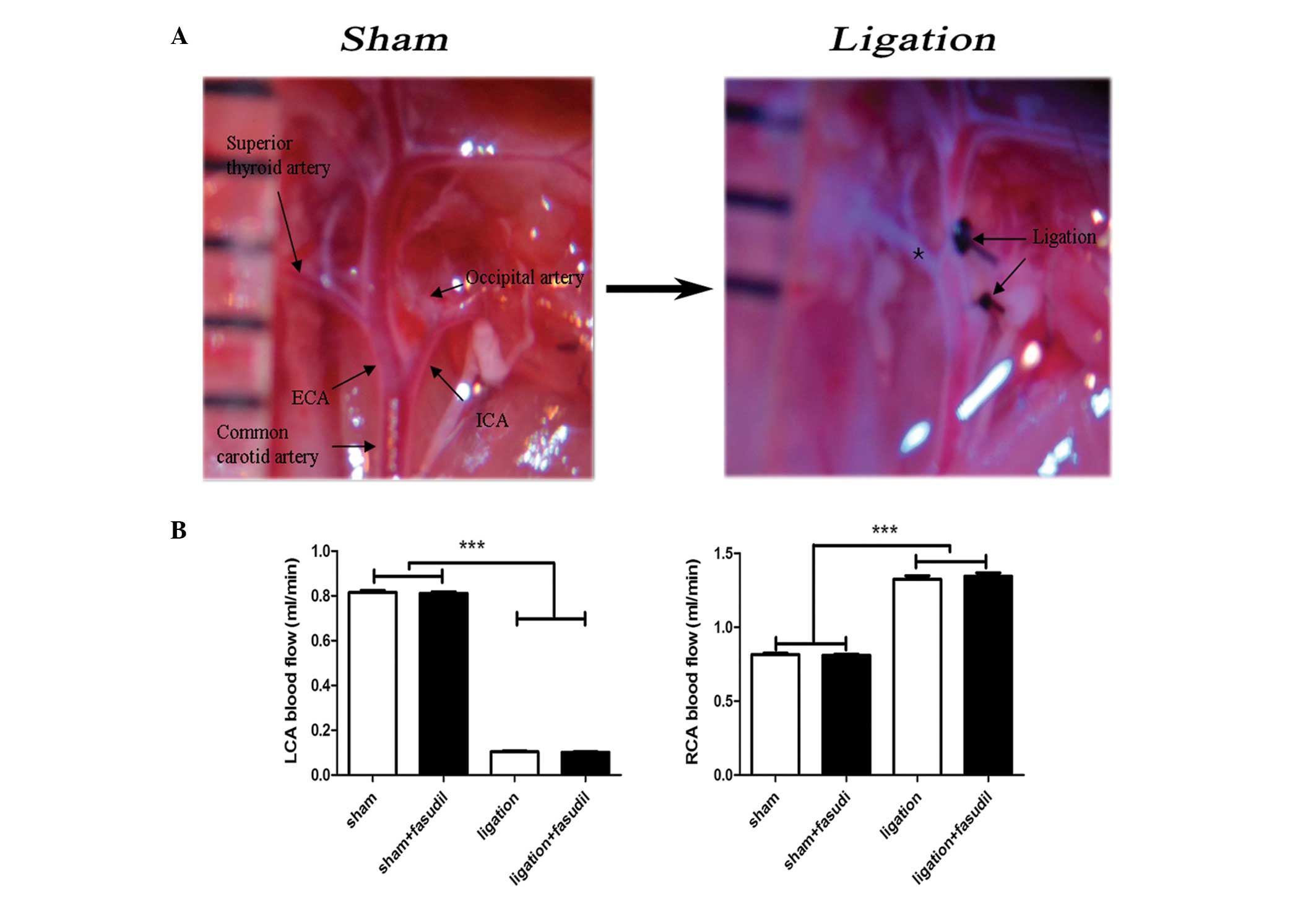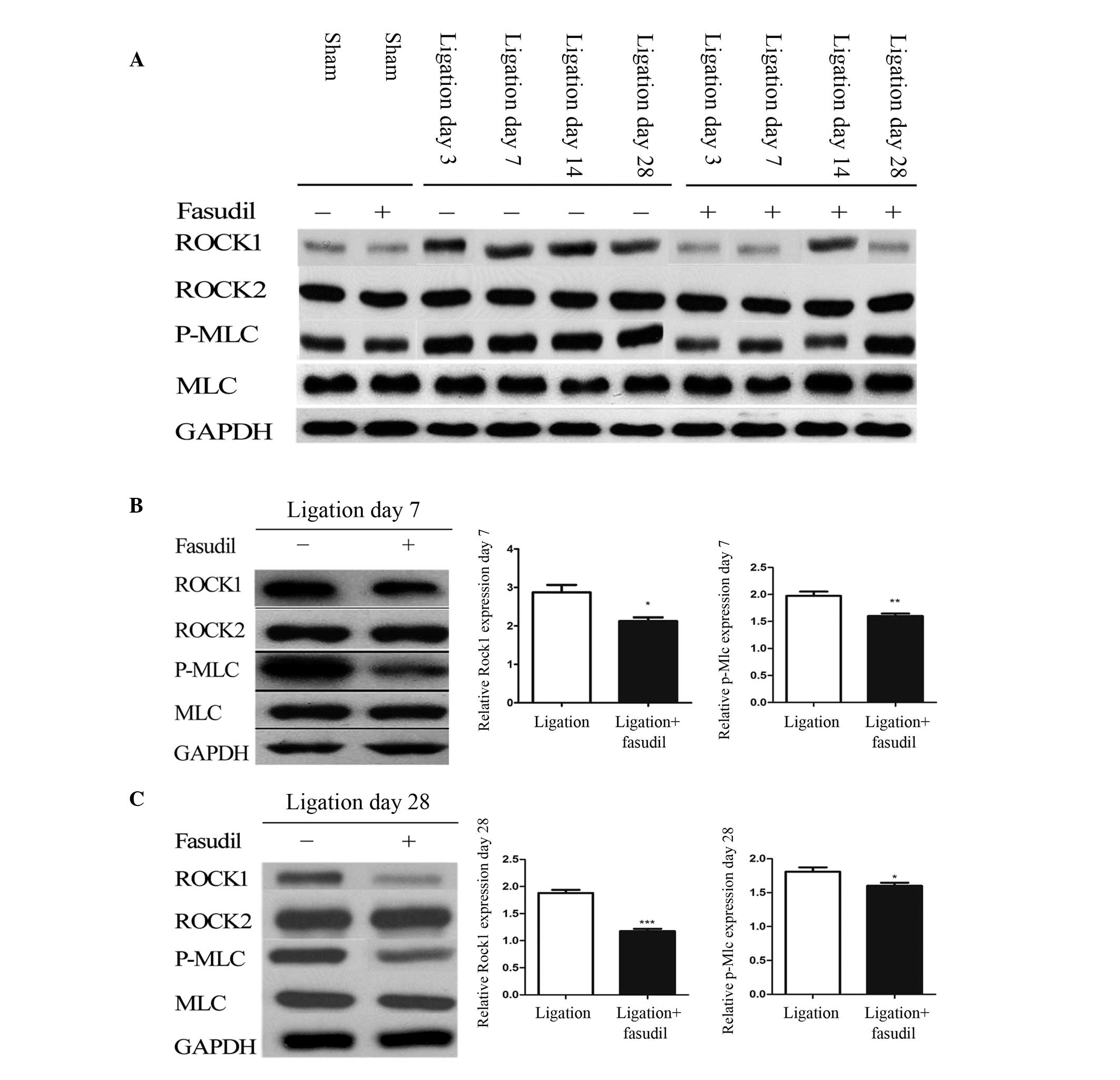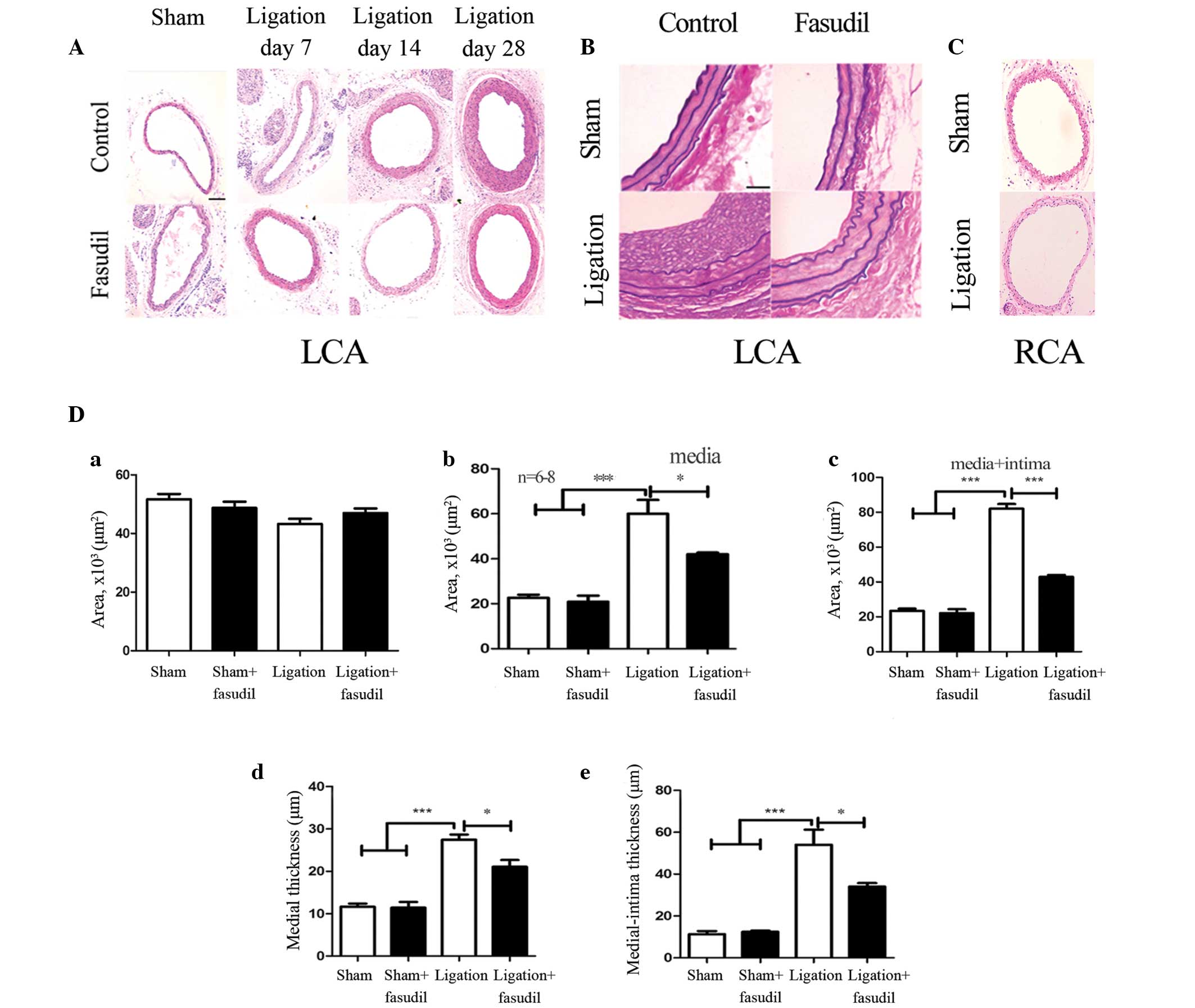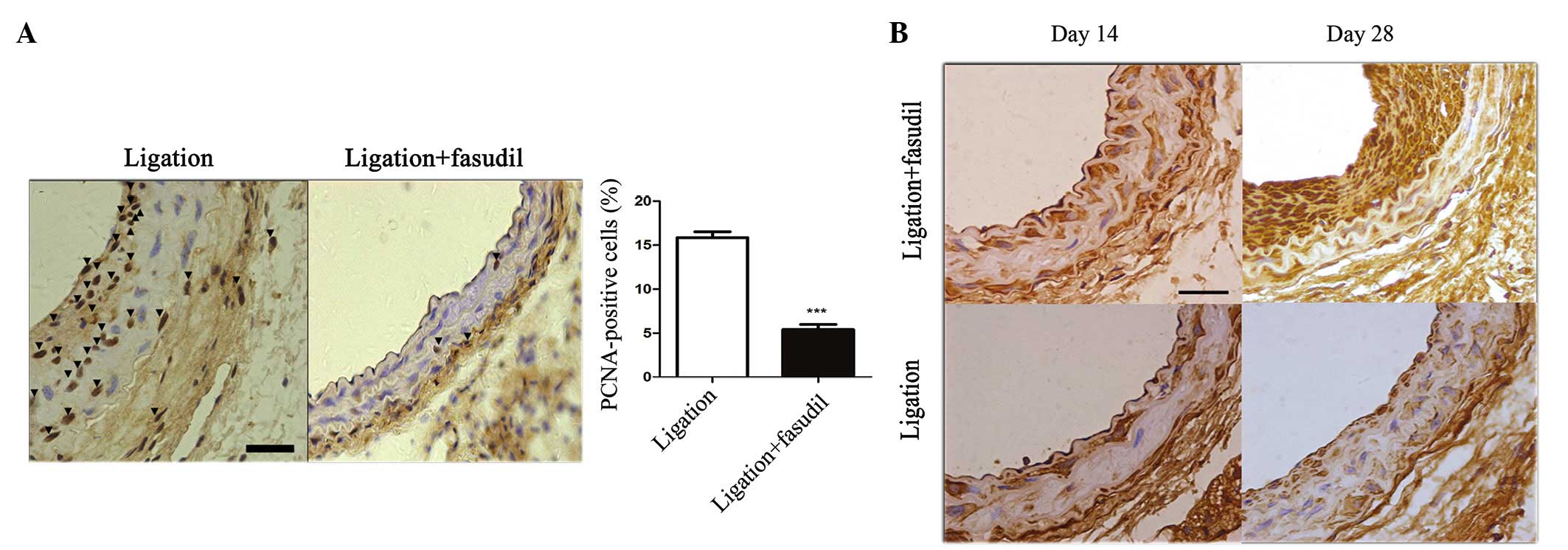|
1
|
Davis PH, Dawson JD, Riley WA and Lauer
RM: Carotid intimal-medial thickness is related to cardiovascular
risk factors measured from childhood through middle age: The
Muscatine Study. Circulation. 104:2815–2819. 2001. View Article : Google Scholar : PubMed/NCBI
|
|
2
|
Cheng KS, Mikhailidis DP, Hamilton G and
Seifalian AM: A review of the carotid and femoral intima-media
thickness as an indicator of the presence of peripheral vascular
disease and cardiovascular risk factors. Cardiovasc Res.
54:528–538. 2002. View Article : Google Scholar : PubMed/NCBI
|
|
3
|
Libby P: Inflammation in atherosclerosis.
Nature. 420:868–874. 2002. View Article : Google Scholar : PubMed/NCBI
|
|
4
|
Pasterkamp G, Galis ZS and de Kleijn DP:
Expansive arterial remodeling: Location, location, location.
Arterioscler Thromb Vasc Biol. 24:650–657. 2004. View Article : Google Scholar : PubMed/NCBI
|
|
5
|
Bobik A and Tkachuk V: Metalloproteinases
and plasminogen activators in vessel remodeling. Curr Hypertens
Rep. 5:466–472. 2003. View Article : Google Scholar : PubMed/NCBI
|
|
6
|
Korshunov Va and Berk BC: Flow-induced
vascular remodeling in the mouse: A model for carotid intima-media
thickening. Arterioscler Thromb Vasc Biol. 23:2185–2191. 2003.
View Article : Google Scholar : PubMed/NCBI
|
|
7
|
Post MJ, Borst C and Kuntz RE: The
relative importance of arterial remodeling compared with intimal
hyperplasia in lumen renarrowing after balloon angioplasty. A study
in the normal rabbit and the hypercholesterolemic Yucatan micropig.
Circulation. 89:2816–2821. 1994. View Article : Google Scholar : PubMed/NCBI
|
|
8
|
Wentzel JJ, Gijsen FJ, Stergiopulos N,
Serruys PW, Slager CJ and Krams R: Shear stress, vascular
remodeling and neointimal formation. J Biomech. 36:681–688. 2003.
View Article : Google Scholar : PubMed/NCBI
|
|
9
|
Wang YX, Martin-McNulty B, da Cunha V,
Vincelette J, Lu X, Feng Q, Halks-Miller M, Mahmoudi M, Schroeder
M, Subramanyam B, et al: Fasudil, a Rho-kinase inhibitor,
attenuates angiotensin II-induced abdominal aortic aneurysm in
apolipo-protein E-deficient mice by inhibiting apoptosis and
proteolysis. Circulation. 111:2219–2226. 2005. View Article : Google Scholar : PubMed/NCBI
|
|
10
|
Shimokawa H and Takeshita A: Rho-kinase is
an important therapeutic target in cardiovascular medicine.
Arterioscler Thromb Vasc Biol. 25:1767–1775. 2005. View Article : Google Scholar : PubMed/NCBI
|
|
11
|
Noma K, Oyama N and Liao JK: Physiological
role of ROCKs in the cardiovascular system. Am J Physiol Cell
Physiol. 290:C661–C668. 2006. View Article : Google Scholar : PubMed/NCBI
|
|
12
|
Sato M, Tani E, Fujikawa H and Kaibuchi K:
Involvement of Rho-kinase-mediated phosphorylation of myosin light
chain in enhancement of cerebral vasospasm. Circ Res. 87:195–200.
2000. View Article : Google Scholar : PubMed/NCBI
|
|
13
|
Masumoto A, Mohri M, Shimokawa H, Urakami
L, Usui M and Takeshita A: Suppression of coronary artery spasm by
the Rho-kinase inhibitor fasudil in patients with vasospastic
angina. Circulation. 105:1545–1547. 2002. View Article : Google Scholar : PubMed/NCBI
|
|
14
|
Uehata M, Ishizaki T, Satoh H, Ono T,
Kawahara T, Morishita T, Tamakawa H, Yamagami K, Inui J, Maekawa M,
et al: Calcium sensitization of smooth muscle mediated by a
Rho-associated protein kinase in hypertension. Nature. 389:990–994.
1997. View Article : Google Scholar : PubMed/NCBI
|
|
15
|
Chen Z and Tzima E: PECAM-1 is necessary
for flow-induced vascular remodeling. Arterioscler Thromb Vasc
Biol. 29:1067–1073. 2009. View Article : Google Scholar : PubMed/NCBI
|
|
16
|
Szendröi M, Labat-Robert J, Godeau G and
Robert AM: Immunohistochemical detection of fibronectin using
different fixatives in paraffin embedded sections. Pathol Biol
(Paris). 31:631–636. 1983.
|
|
17
|
Erami C, Zhang H, Tanoue A, Tsujimoto G,
Thomas SA and Faber JE: Adrenergic catecholamine trophic activity
contributes to flow-mediated arterial remodeling. Am J Physiol
Heart Circ Physiol. 289:H744–H753. 2005. View Article : Google Scholar : PubMed/NCBI
|
|
18
|
Chatzizisis YS and Giannoglou GD:
Pulsatile flow: A critical modulator of the natural history of
atherosclerosis. Med Hypotheses. 67:338–340. 2006. View Article : Google Scholar : PubMed/NCBI
|
|
19
|
Stone PH, Coskun AU, Yeghiazarians Y,
Kinlay S, Popma JJ, Kuntz RE and Feldman CL: Prediction of sites of
coronary atherosclerosis progression: In vivo profiling of
endothelial shear stress, lumen and outer vessel wall
characteristics to predict vascular behavior. Curr Opin Cardiol.
18:458–470. 2003. View Article : Google Scholar : PubMed/NCBI
|
|
20
|
Silver AE and Vita JA:
Shear-stress-mediated arterial remodeling in atherosclerosis: too
much of a good thing? Circulation. 113:2787–2789. 2006. View Article : Google Scholar : PubMed/NCBI
|
|
21
|
Korshunov VA and Berk BC: Strain-dependent
vascular remodeling: The 'Glagov phenomenon' is genetically
determined. Circulation. 110:220–226. 2004. View Article : Google Scholar : PubMed/NCBI
|
|
22
|
Korshunov VA, Mohan AM, Georger MA and
Berk BC: Axl, a receptor tyrosine kinase, mediates flow-induced
vascular remodeling. Circ Res. 98:1446–1452. 2006. View Article : Google Scholar : PubMed/NCBI
|
|
23
|
Phillips JW, Barringhaus KG, Sanders JM,
Hesselbacher SE, Czarnik AC, Manka D, Vestweber D, Ley K and
Sarembock IJ: Single injection of P-selectin or P-selectin
glycoprotein ligand-1 monoclonal antibody blocks neointima
formation after arterial injury in apolipoprotein E-deficient mice.
Circulation. 107:2244–2249. 2003. View Article : Google Scholar : PubMed/NCBI
|
|
24
|
Korshunov VA, Schwartz SM and Berk BC:
Vascular remodeling: Hemodynamic and biochemical mechanisms
underlying Glagov's phenomenon. Arterioscler Thromb Vasc Biol.
27:1722–1728. 2007. View Article : Google Scholar : PubMed/NCBI
|
|
25
|
Ibrahim J, Miyashiro JK and Berk BC: Shear
stress is differentially regulated among inbred rat strains. Circ
Res. 92:1001–1009. 2003. View Article : Google Scholar : PubMed/NCBI
|
|
26
|
Matsumoto Y, Uwatoku T, Oi K, Abe K,
Hattori T, Morishige K, Eto Y, Fukumoto Y, Nakamura K, Shibata Y,
et al: Long-term inhibition of Rho-kinase suppresses neointimal
formation after stent implantation in porcine coronary arteries:
involvement of multiple mechanisms. Arterioscler Thromb Vasc Biol.
24:181–186. 2004. View Article : Google Scholar
|
|
27
|
Miyata K, Shimokawa H, Kandabashi T, Higo
T, Morishige K, Eto Y, Egashira K, Kaibuchi K, Takeshita A, et al:
Rho-kinase is involved in macrophage-mediated formation of coronary
vascular lesions in pigs in vivo. Arterioscler Thromb Vasc Biol.
20:2351–2358. 2000. View Article : Google Scholar : PubMed/NCBI
|
|
28
|
Pearce JD, Li J, Edwards MS, English WP
and Geary RL: Differential effects of Rho-kinase inhibition on
artery wall mass and remodeling. J Vasc Surg. 39:223–228. 2004.
View Article : Google Scholar : PubMed/NCBI
|
|
29
|
Wu DJ, Xu JZ, Wu YJ, Jean-Charles L, Xiao
B, Gao PJ and Zhu DL: Effects of fasudil on early atherosclerotic
plaque formation and established lesion progression in
apolipoprotein E-knockout mice. Atherosclerosis. 207:68–73. 2009.
View Article : Google Scholar : PubMed/NCBI
|
|
30
|
Grimm M, Haas P, Willipinski-Stapelfeldt
B, Zimmermann WH, Rau T, Pantel K, Weyand M and Eschenhagen T: Key
role of myosin light chain (MLC) kinase-mediated MLC2a
phosphorylation in the alpha 1-adrenergic positive inotropic effect
in human atrium. Cardiovasc Res. 65:211–220. 2005. View Article : Google Scholar
|
|
31
|
Rajashree R, Blunt BC and Hofmann PA:
Modulation of myosin phosphatase targeting subunit and protein
phosphatase 1 in the heart. Am J Physiol Heart Circ Physiol.
289:H1736–H1743. 2005. View Article : Google Scholar : PubMed/NCBI
|
|
32
|
Davis JS, Hassanzadeh S, Winitsky S, Lin
H, Satorius C, Vemuri R, Aletras AH, Wen H and Epstein ND: The
overall pattern of cardiac contraction depends on a spatial
gradient of myosin regulatory light chain phosphorylation. Cell.
107:631–641. 2001. View Article : Google Scholar : PubMed/NCBI
|
|
33
|
Wettschureck N and Offermanns S:
Rho/Rho-kinase mediated signaling in physiology and
pathophysiology. J Mol Med (Berl). 80:629–638. 2002. View Article : Google Scholar
|
|
34
|
Noma K, Rikitake Y, Oyama N, Yan G,
Alcaide P, Liu PY, Wang H, Ahl D, Sawada N, Okamoto R, et al: ROCK1
mediates leukocyte recruitment and neointima formation following
vascular injury. J Clin Invest. 118:1632–1644. 2008. View Article : Google Scholar : PubMed/NCBI
|
|
35
|
Ming XF, Viswambharan H, Barandier C,
Ruffieux J, Kaibuchi K, Rusconi S and Yang Z: Rho GTPase/Rho kinase
negatively regulates endothelial nitric oxide synthase
phosphorylation through the inhibition of protein kinase B/Akt in
human endothelial cells. Mol Cell Biol. 22:8467–8477. 2002.
View Article : Google Scholar : PubMed/NCBI
|
|
36
|
Ohashi K, Nagata K, Maekawa M, Ishizaki T,
Narumiya S and Mizuno K: Rho-associated kinase ROCK activates
LIM-kinase 1 by phosphorylation at threonine 508 within the
activation loop. J Biol Chem. 275:3577–3582. 2000. View Article : Google Scholar : PubMed/NCBI
|
|
37
|
Davies SP, Reddy H, Caivano M and Cohen P:
Specificity and mechanism of action of some commonly used protein
kinase inhibitors. Biochem J. 351:95–105. 2000. View Article : Google Scholar : PubMed/NCBI
|
|
38
|
Bain J, Plater L, Elliott M, Shpiro N,
Hastie CJ, McLauchlan H, Klevernic I, Arthur JS, Alessi DR and
Cohen P: The selectivity of protein kinase inhibitors: A further
update. Biochem J. 408:297–315. 2007. View Article : Google Scholar : PubMed/NCBI
|
|
39
|
Liao JK, Seto M and Noma K: Rho kinase
(ROCK) inhibitors. J Cardiovasc Pharmacol. 50:17–24. 2007.
View Article : Google Scholar : PubMed/NCBI
|














